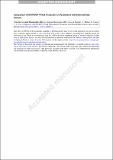| dc.contributor.author | Wautelet, Gilles | |
| dc.contributor.author | Hubert, Benoît | |
| dc.contributor.author | Gérard, Jean-Claude | |
| dc.contributor.author | Immel, Thomas J. | |
| dc.contributor.author | Sirk, Martin M. | |
| dc.contributor.author | Korpela, Eric J. | |
| dc.contributor.author | Stephan, Andrew W. | |
| dc.contributor.author | Mende, Stephen B. | |
| dc.contributor.author | England, Scott L. | |
| dc.contributor.author | Erickson, Philip J. | |
| dc.date.accessioned | 2022-11-08T14:55:32Z | |
| dc.date.available | 2022-11-08T14:55:32Z | |
| dc.date.issued | 2022-11-07 | |
| dc.identifier.uri | https://hdl.handle.net/1721.1/146209 | |
| dc.description.abstract | Abstract
We provide the first comparison of the ICON-EUV O+ density profile with radio wave datasets coming from GNSS radio-occultation, ionosondes and incoherent scatter radar. The peak density and height deduced from those different observation techniques are compared. It is found that the EUV-deduced peak density is smaller than that from other techniques by 50 to 60%, while the altitude of the peak is retrieved with a slight bias of 10 to 20 km on average. These average values are found to vary between November 2019 and March 2021. Magnetic latitude and local time are not factors significantly influencing this variability. In contrast, the EUV density is closer to that deduced from radio-wave techniques in the mid latitude region, i.e. where the ionospheric crests do not play a role. The persistent very low solar activity conditions prevailing during the studied time interval challenge the EUV O+ density profile retrieval technique. These values are consistent, both in magnitude and direction, with a systematic error on the order of 10% in the data or the forward model, or a combination of both. Ultimately, the EUV instrument on-board ICON provides the only known technique capable of precisely monitoring the ionospheric peak properties at daytime from a single space platform, on a global scale and at high cadence. This feature paves the way to transpose the technology to the study of the ionosphere surrounding other planets. | en_US |
| dc.publisher | Springer Netherlands | en_US |
| dc.relation.isversionof | https://doi.org/10.1007/s11214-022-00930-2 | en_US |
| dc.rights | Article is made available in accordance with the publisher's policy and may be subject to US copyright law. Please refer to the publisher's site for terms of use. | en_US |
| dc.source | Springer Netherlands | en_US |
| dc.title | Comparison of ICON-EUV F-Peak Characteristic Parameters with External Data Sources | en_US |
| dc.type | Article | en_US |
| dc.identifier.citation | Space Science Reviews. 2022 Nov 07;218(8):62 | en_US |
| dc.contributor.department | Haystack Observatory | en_US |
| dc.eprint.version | Author's final manuscript | en_US |
| dc.type.uri | http://purl.org/eprint/type/JournalArticle | en_US |
| eprint.status | http://purl.org/eprint/status/PeerReviewed | en_US |
| dc.date.updated | 2022-11-08T04:20:49Z | |
| dc.language.rfc3066 | en | |
| dc.rights.holder | The Author(s), under exclusive licence to Springer Nature B.V. | |
| dspace.embargo.terms | Y | |
| dspace.date.submission | 2022-11-08T04:20:49Z | |
| mit.license | PUBLISHER_POLICY | |
| mit.metadata.status | Authority Work and Publication Information Needed | en_US |
